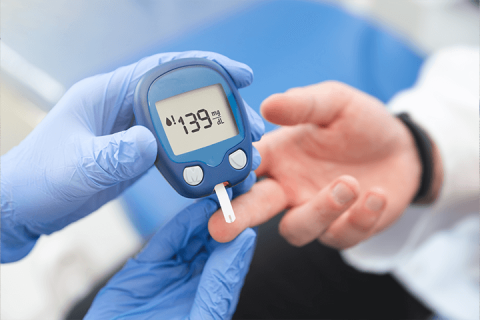
Did you know more than 38 million people in the U.S. have diabetes, and almost 98 million have prediabetes? The number of Americans who’ve been diagnosed with diabetes has more than doubled in the last 20 years!
But here’s perhaps the most troubling number of all: about 17% of Americans who have diabetes are undiagnosed – that’s nearly nine million people who have a dangerous chronic condition that’s going untreated and unmonitored!
This is why it’s so important to keep up with your preventive care and use the resources available through your TRS health plan to get and stay healthy. November is American Diabetes Month®, so there’s no better time to focus on healthy habits that can keep diabetes in check or keep it at bay.
Here are some tips.
1. See Your Doctor Regularly
Keeping up with preventive care is important for everyone, but it’s especially critical if you’re pre-diabetic or at risk for diabetes.
For those who have already been diagnosed, regular doctor appointments and screenings are the best way to make sure you’re on track. Diabetics typically see their doctor more often to check blood sugar and other measurements. That's how you know your diabetes is controlled or if you need to change your management plan.
What Tests Do You Need?
Your doctor will tell you what you need and when, but here are some of the most important tests for diabetics:
- A1C – The hemoglobin A1C test measures your average blood sugar levels over a two-to-three-month period.
- Diabetic Eye Exam – Diabetic eye disease is one of the leading causes of blindness, and there are often no early warning signs. That’s why it’s important to have regular diabetic eye exams with dilation and keep up with recommended care plans.
- Urine and Blood Tests to Check Kidney Function – These regular checks will look for:
- proteins in your urine that could be a sign of kidney disease
- the creatinine level in your blood to make sure your kidneys are removing this waste product
- Blood Tests for Anemia – About 25% of Americans with diabetes are anemic, meaning they have low red blood cell counts. This can cause nerve and eye damage and worsen conditions like heart, artery and kidney disease.
- Blood Pressure Test – High blood pressure is especially dangerous with diabetes because it raises your risk for heart attack and stroke.
- Cholesterol – Diabetics are at higher risk for high cholesterol, which can cause heart attacks and strokes.
- Diabetic Foot Exam – Your doctor will check your feet to make sure you don’t have nerve damage or circulation problems related to diabetes.
2. Monitor Your Blood Sugar
Blood sugar varies throughout the day and is affected by:
- what you eat
- your activity level
- medications you take
Your doctor will let you know if you should be testing at home, and how often. They should also give you a plan for what to do if your blood sugar is too high or low. The American Diabetes Association recommends regular monitoring to make sure your blood sugar is in range or allow you to act quickly if it's not.
3. Eat Right

Eating a balanced diet is essential for diabetes management. These tips from the ADA will help you make healthy choices:
- Focus on fish and lean meats and prepare them grilled, baked or broiled. Limit high-fat meat and fried options. Good protein choices for vegetarians and vegans include beans, hummus, quinoa, lentils, and tofu.
- Include dairy. You can include moderate portions of milk, yogurt and cottage cheese in a diabetic diet. It’s best to stay away from full-fat versions, and be sure to watch the sugar that can be hiding in foods like yogurt.
- Add in “healthy" fats. Nuts, olive oil and avocados may help lower your heart disease risk.
- Eat fruit in moderation. Fruit has natural sugar but is also loaded with vitamins, minerals and fiber. Lower glycemic fruits like apples, berries, cherries and oranges have less impact on blood sugar, but you’ll still want to check for spikes.
- Dump high-sugar and high-calorie drinks like sodas and juices. These can send your sugar levels flying. They also add unnecessary calories.
- Pay attention to portion size. These are considered “normal” serving sizes:
- Have a baseball handy? That’s equal to one serving of pasta.
- What does one serving of meat like chicken or steak look like? Grab a deck of playing cards.
- If you’re having a baked potato, you can measure it against your computer mouse. That’s one serving!
- Check food labels and restaurant menus for hidden calories. It may be shocking to see how a typical entrée at your fave dining spot measures up.
- Limit your sugar, carbs and fat. That includes:
- potatoes
- grains like rice
- white and wheat flour-based pasta
- breads
- tortilla chips
- sweets including cookies, candy, cake and pastries
When in doubt, use the Diabetes Plate Method: Fill half of a nine-inch plate with non-starchy vegetables like broccoli or cauliflower, one quarter with lean protein and one quarter with carbs.
4. Get Active!
Exercise can lower blood sugar levels and improve insulin sensitivity. And here’s a surprising side effect: exercise can also improve your mood, which is important for the 40% of diabetics who studies say have depression.
Here are some tips for exercising with diabetes:
- Get at least 150 minutes of moderate-intensity aerobic activity or 75 minutes of vigorous-intensity aerobic activity each week.
- Do muscle-strengthening activities two or more times per week.
- Do what you like! You can boost your chances of sticking to a fitness plan by tailoring it to include the activities you enjoy. Take a walk in nature, go for a bike ride, play pickleball, or dance in your kitchen. Who says fitness can’t be fun?
- Be sure to check with your doctor before starting any fitness plan.
5. Take Your Meds
If you've been prescribed medication, make sure you take it according to the directions. Skipping doses could put your health at risk.
Your TRS-ActiveCare or TRS-Care Standard plan may include no-cost generic preventive drugs and supplies for diabetes management.
- Formulary Insulin:
- $25 copay for 31-day supply and $75 copay for a 60- to 90-day supply for TRS-ActiveCare Primary, TRS-ActiveCare Primary+, TRS-ActiveCare 2 and TRS-Care Standard
- 25% coinsurance after deductible for TRS-ActiveCare HD
Needles, lancets and syringes:
These diabetic supplies are no-cost for a 31-day or 90-day supply for all TRS-ActiveCare and TRS-Care Standard plans.
Copays or coinsurance may apply for non-formulary or brand name insulin.
Be sure to reach out to your provider with concerns about your medication or call a Personal Health Guide at 1-866-355-5999, 24 hours a day, seven days a week, for help with diabetic supplies and equipment. A PHG can also help you find a provider or make an appointment.
Resources for TRS-ActiveCare and TRS-Care Standard
Provider Finder®
Easily find an in-network provider. Preventive care is covered at 100% with in-network providers. That includes diabetes screenings.
Provider Finder® for TRS-ActiveCare
Provider Finder® for TRS-Care Standard
Well onTarget®
Through Well onTarget, you have no-cost, one-on-one coaching with a registered dietician who can help you develop and stick to a healthy eating plan. There are also personal trainers who can help you develop a fitness plan and other credentialed professionals who support programs to help lower your cholesterol or blood pressure, quit smoking and manage stress.
Well onTarget® for TRS-ActiveCare
Well onTarget® for TRS-Care Standard
Fitness Program
You and your covered dependents have access to the Fitness Program, with a variety of in-person and digital fitness options.
Fitness Program for TRS-ActiveCare
Fitness Program for TRS-Care Standard
Resources for TRS-Care Medicare Advantage
Let’s Move
Let's Move by UnitedHealthcare is here to help keep your mind, body and social life active – at no additional cost to you. With simple resources, tools, events and personalized support, Let’s Move helps you explore ways to eat well, stay connected and be financially, physically and mentally fit — all at no additional cost to you.
To explore, visit Letsmovebyuhc.com through your member website.
You can also participate in live, virtual events to learn how to cook healthy meals, be physically active and explore other wellness topics by visiting the events page.
Rewards
With the TRS-Care Medicare Advantage plan, you can earn rewards for things you probably already do, like completing your annual physical and wellness visit. Once you have attested to your first Reward item, you will receive a credit on your UnitedHealthcare UCard that you can use to shop for eligible items in-store or online at participating retailers nationwide. For more information about rewards available to you, sign in or register on your member website at retiree.uhc.com/TRS-CareMA.